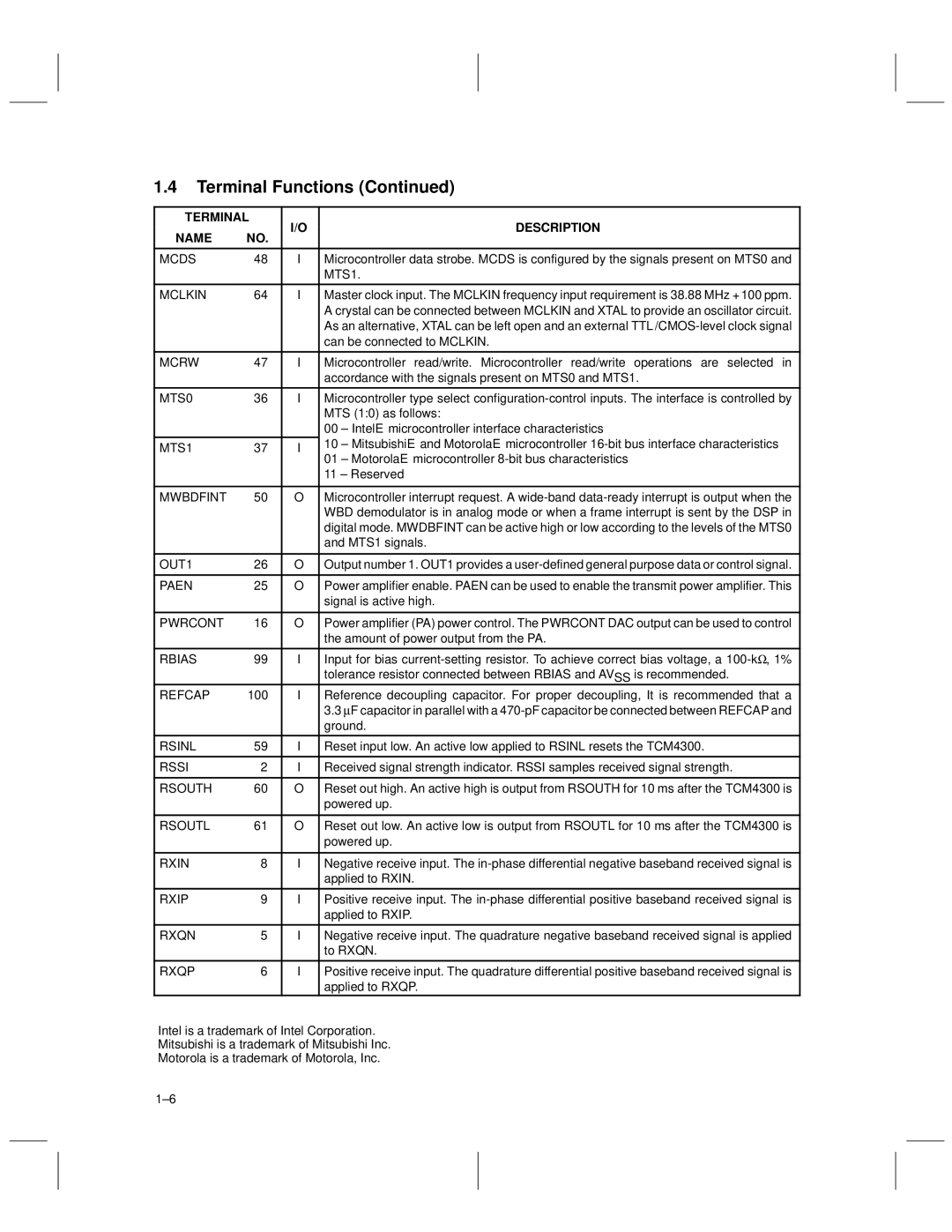
1.4Terminal Functions (Continued)
TERMINAL | I/O | DESCRIPTION | ||
NAME | NO. | |||
|
| |||
|
|
|
| |
MCDS | 48 | I | Microcontroller data strobe. MCDS is configured by the signals present on MTS0 and | |
|
|
| MTS1. | |
|
|
|
| |
MCLKIN | 64 | I | Master clock input. The MCLKIN frequency input requirement is 38.88 MHz ± 100 ppm. | |
|
|
| A crystal can be connected between MCLKIN and XTAL to provide an oscillator circuit. | |
|
|
| As an alternative, XTAL can be left open and an external | |
|
|
| can be connected to MCLKIN. | |
|
|
|
| |
MCRW | 47 | I | Microcontroller read/write. Microcontroller read/write operations are selected in | |
|
|
| accordance with the signals present on MTS0 and MTS1. | |
|
|
|
| |
MTS0 | 36 | I | Microcontroller type select | |
|
|
| MTS (1:0) as follows: | |
|
|
| 00 ± Intel microcontroller interface characteristics | |
MTS1 | 37 | I | 10 ± Mitsubishi and Motorola microcontroller | |
01 ± Motorola microcontroller | ||||
|
|
| ||
|
|
| 11 ± Reserved | |
|
|
|
| |
MWBDFINT | 50 | O | Microcontroller interrupt request. A | |
|
|
| WBD demodulator is in analog mode or when a frame interrupt is sent by the DSP in | |
|
|
| digital mode. MWDBFINT can be active high or low according to the levels of the MTS0 | |
|
|
| and MTS1 signals. | |
|
|
|
| |
OUT1 | 26 | O | Output number 1. OUT1 provides a | |
|
|
|
| |
PAEN | 25 | O | Power amplifier enable. PAEN can be used to enable the transmit power amplifier. This | |
|
|
| signal is active high. | |
|
|
|
| |
PWRCONT | 16 | O | Power amplifier (PA) power control. The PWRCONT DAC output can be used to control | |
|
|
| the amount of power output from the PA. | |
|
|
|
| |
RBIAS | 99 | I | Input for bias | |
|
|
| tolerance resistor connected between RBIAS and AVSS is recommended. | |
REFCAP | 100 | I | Reference decoupling capacitor. For proper decoupling, It is recommended that a | |
|
|
| 3.3 μF capacitor in parallel with a | |
|
|
| ground. | |
|
|
|
| |
RSINL | 59 | I | Reset input low. An active low applied to RSINL resets the TCM4300. | |
|
|
|
| |
RSSI | 2 | I | Received signal strength indicator. RSSI samples received signal strength. | |
|
|
|
| |
RSOUTH | 60 | O | Reset out high. An active high is output from RSOUTH for 10 ms after the TCM4300 is | |
|
|
| powered up. | |
|
|
|
| |
RSOUTL | 61 | O | Reset out low. An active low is output from RSOUTL for 10 ms after the TCM4300 is | |
|
|
| powered up. | |
|
|
|
| |
RXIN | 8 | I | Negative receive input. The | |
|
|
| applied to RXIN. | |
|
|
|
| |
RXIP | 9 | I | Positive receive input. The | |
|
|
| applied to RXIP. | |
|
|
|
| |
RXQN | 5 | I | Negative receive input. The quadrature negative baseband received signal is applied | |
|
|
| to RXQN. | |
|
|
|
| |
RXQP | 6 | I | Positive receive input. The quadrature differential positive baseband received signal is | |
|
|
| applied to RXQP. | |
Intel is a trademark of Intel Corporation.
Mitsubishi is a trademark of Mitsubishi Inc.
Motorola is a trademark of Motorola, Inc.
1±6
